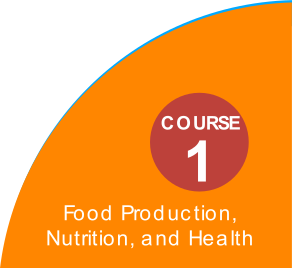Food For Thought

This is a project-based foundational course to introduce students to the size and scope of food production, nutrition, and health, and the underlying principles. Students will define the food science industry, describe historical milestones, and analyze how the production, processing, distribution, and marketing of food and food products influence consumer behavior and health. Students will apply knowledge about food products, nutrients, and the chemical and physical properties of food to solve human nutrition and health problems. Upon completion of this course, students are prepared to enroll in either Food Science or Nutrition Science courses within this program of study in preparation for careers in those areas.
Essential Question
How should we monitor our eating to maintain a healthy lifestyle?
Engagement Scenario
Malnutrition occurs in people who are either undernourished or over-nourished. Approximately 30% of children in the United States are obese while 1% are undernourished. Many people have no idea what they actually eat in a given day and whether they are making good food decisions. Your CTSO (FFA, FCCLA, HOSA, etc.) has asked you – as a member of the organization’s healthy lifestyle committee – to write a food diary for high school students and develop the tools students would need to use the diary. They will use the food diary the class develops for a healthy lifestyle program they are conducting. The goal is to help students become more aware of the foods they consume and the impact those foods could have on overall health.
Your team will research healthy eating and determine guidelines for adolescents to follow. Based on the guidelines, your team will develop a food diary that allows you to track food and calorie consumption. You will use the food diary you develop and test it among your peers for usability. You will compare your eating habits and the habits of your peers to those suggested by your research using pie charts. You will calculate the necessary caloric intake for an individual based on Resting Metabolic Rate and activity levels and use this caloric intake recommendation in the guide for your food diary.
After reading informational texts on nutrition and participating in enabling learning activities intended to assist you in researching, conducting, and analyzing an approach to monitoring proper nutrition, write a report in which you analyze the effectiveness of your food diary, providing examples to illustrate and clarify your analysis.
You will present your food diary, eating data, and usability results to a nutrition expert and leaders in the student organization and apply their feedback and the usability feedback you receive from your peers to revise your food diary. As a class, you will choose a food diary to use for the remainder of the course.
Course 1 Unit 1 Complete Curriculum
Appendices
| Day 1 | Day 2 | Day 3 | Day 4 | Day 5 |
| Day 6 | Day 7 | Day 8 | Day 9 | Day 10 |
|
None |
None |
None |
||
| Day 11 | Day 12 | Day 13 | Day 14 | Day 15 |
|
None |
||||
| Day 16 | Day 17 | Day 18 | Day 19 | Day 20 |
Videos
Day 8 - What Is Your Resting Metabolism Rate - Express Metabolics
Additional Resources
Where do Americans Really Get Their Calories? Not Where You Think